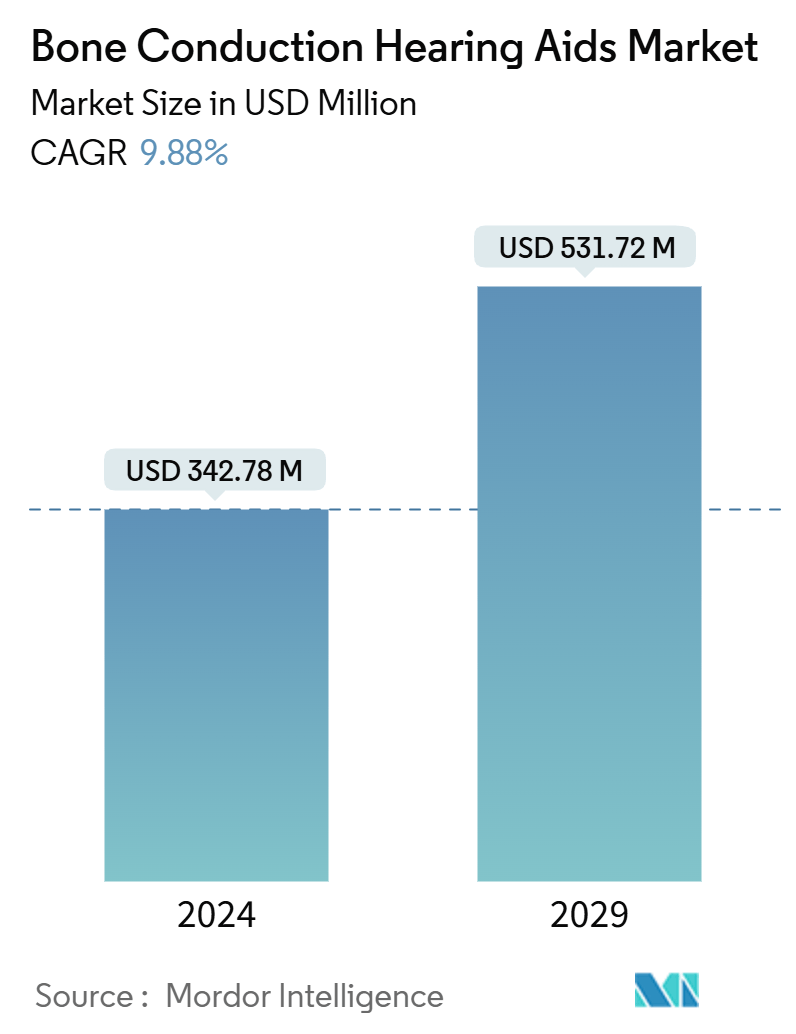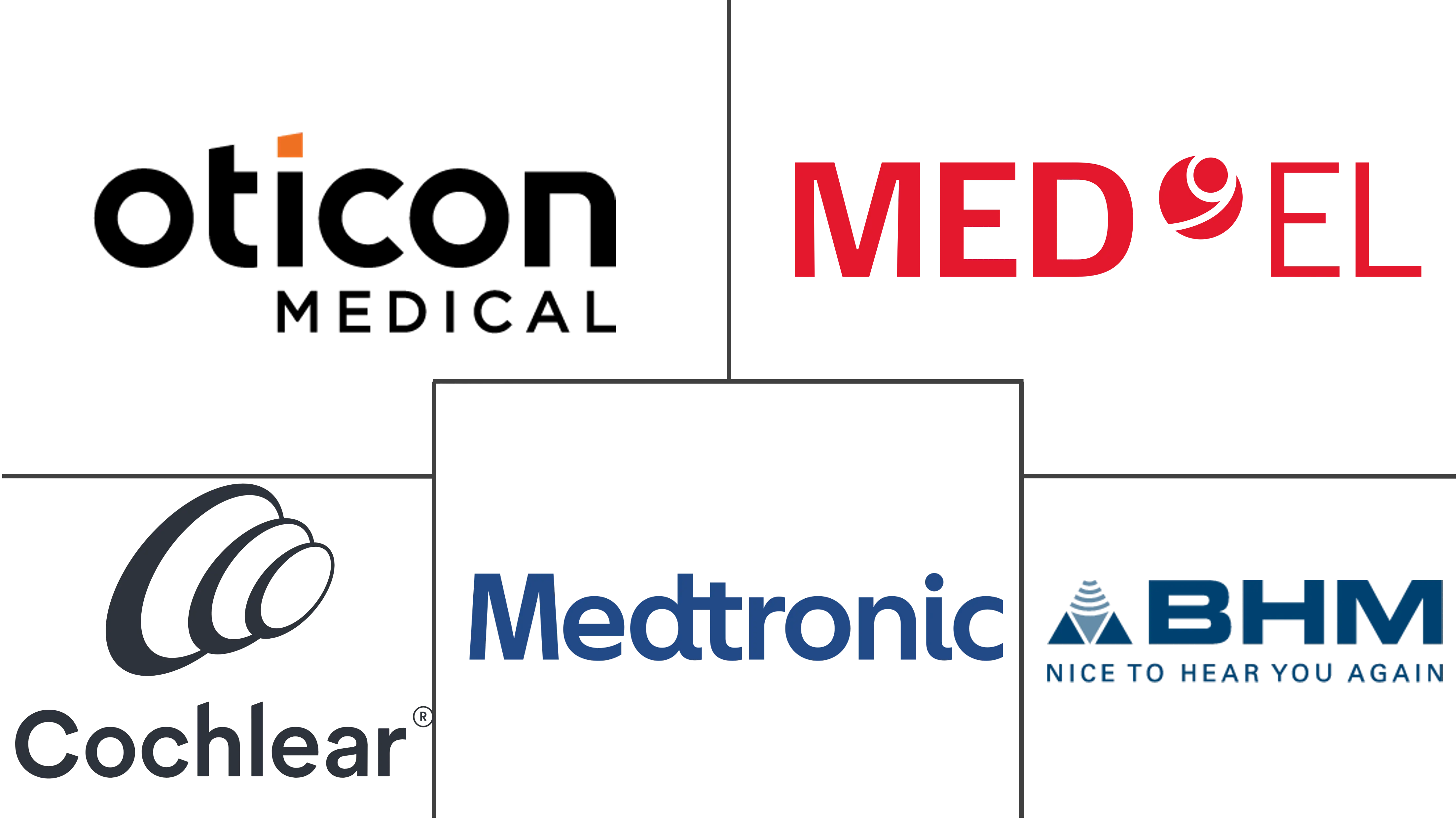Market Size of Bone Conduction Hearing Aids Industry

| Study Period | 2019 - 2029 |
| Market Size (2024) | USD 342.78 Million |
| Market Size (2029) | USD 531.72 Million |
| CAGR (2024 - 2029) | 9.88 % |
| Fastest Growing Market | Asia Pacific |
| Largest Market | North America |
| Market Concentration | High |
Major Players
*Disclaimer: Major Players sorted in no particular order |
Bone Conduction Hearing Aids Market Analysis
The Bone Conduction Hearing Aids Market size is estimated at USD 342.78 million in 2024, and is expected to reach USD 531.72 million by 2029, at a CAGR of 9.88% during the forecast period (2024-2029).
Factors such as the technological advancements in bone-conduction hearing aids coupled with the growing incidence of hearing loss in geriatrics, increasing healthcare spending, and the high demand for bone-conduction hearing aids are expected to boost the market growth over the projected period.
The burden of hearing impairment in the geriatric population is relatively high, which is the key factor driving the market growth. Age-associated hearing loss is common among older adults. The World Health Organization (WHO) in February 2023, estimated that one in three people over 65 experience hearing loss, creating a significant need for hearing assistance. Additionally, an article published in JAMA Network in July 2023, indicated that 65.3% of adults aged 71 and older experienced hearing loss, with prevalence rising to 96.2% for those aged 90 and above. Among the oldest adults, 35.8% had mild, 38.8% moderate, and 9.6% severe hearing loss. Despite this high prevalence, only 29.2% utilized hearing aids. Hence, the high prevalence of hearing loss drives demand for diverse hearing solutions, with bone-conducting hearing aids offering a viable alternative for many users, thereby boosting market growth.
The increasing number of elderly individuals seeking effective solutions to manage their hearing loss directly propels the market for bone-conducting hearing aids, which are often more comfortable and less noticeable than traditional options. For instance, as per the United Nations Report 2023, Most least developed countries boasted a youthful age structure. Only 3.7% of their populations were aged 65 years or older, in contrast to 9% in other developing nations and 20% in developed countries in 2023 and it is projected that by 2050, the number of people aged 60 and older will reach 2.1 billion. This significant increase implies a larger segment of the population will be susceptible to age-related health issues, including hearing loss.
The growing technological advancements in bone conduction hearing aids are expected to increase their adoption among the population who are either suffering from hearing loss or are deaf. For instance, according to an article published in the Current Otorhinolaryngology Reports in November 2023, the percutaneous Osseointegrated devices offered the finest sound conduction and hearing fidelity. Also, the transcutaneous devices limit skin and wound complications, optimize bone conduction efficiency, and reduce the incidence of skin complications. Thus, the advantages offered by the advanced hearing aids are expected to increase its adoption, hence bolstering the market growth.
Furthermore, rising product launches and approvals also contribute to the market growth. For instance, in April 2024, WeHear developed non-surgical solutions tailored for individuals experiencing hearing loss. Their innovative bone conduction hearing aid, HearNU, achieved sales exceeding 11,500 units from 2021 to April 2024. The HearNU features a Bluetooth-connected wearable band that utilizes bone conduction technology to enhance its hearing aid capabilities. Such innovative launches in the market are expected to propel the market over the projected period.
As a result of the rising prevalence of hearing loss and advancements in bone-conduction hearing aid technology, the market is projected to expand during the forecast period. Nevertheless, challenges such as discomfort and pain associated with hearing aids, coupled with the premium pricing of bone-conduction variants, may impede the market's growth trajectory.
Bone Conduction Hearing Aids Industry Segmentation
Bone conduction is a reliable method of sound transmission that can be used to amplify hearing. Bone conduction hearing devices may be indicated when ear canal pathology precludes the use of a conventional hearing aid, as well as in cases of single-sided deafness. The device works by conducting the sound waves directly to the cochlea through the earbone.
The bone conduction hearing aids market is segmented by type, product, patient type, and geography. By type, the market is segmented as bone-anchored hearing aids and traditional bone conduction hearing aids. By product, the market is segmented into systems, accessories, and sound processors. By patient type, the market is segmented as children/pediatrics and adults. By geography, the market is segmented as North America, Europe, Asia-Pacific, Middle East and Africa, and South America. The market report also covers the estimated sizes and trends for 17 different countries across major regions globally.
The report offers the value (in USD) for the above segments.
| By Type | |
| Bone Anchored Hearing Aids | |
| Traditional Bone Conduction Hearing Aids |
| By Product | |
| Systems | |
| Accessories | |
| Sound Processors |
| Patient Type | |
| Children/Pediatrics | |
| Adults |
| Geography | ||||||||
| ||||||||
| ||||||||
| ||||||||
| ||||||||
|
Bone Conduction Hearing Aids Market Size Summary
The bone conduction hearing aids market is experiencing significant growth, driven by technological advancements and an increasing prevalence of hearing loss, particularly among the elderly population. The market's expansion is supported by the rising demand for innovative hearing solutions that bypass traditional auditory pathways, offering improved sound conduction and fidelity. The geriatric demographic, which is more susceptible to hearing impairments, is a key driver of market demand. Additionally, the market is benefiting from increased healthcare spending and the development of new products that enhance user experience and reduce complications associated with traditional hearing aids. Despite challenges such as high costs and potential discomfort, the market is expected to grow steadily over the forecast period.
North America is anticipated to hold a significant share of the bone conduction hearing aids market, fueled by a combination of factors including a growing aging population, rising incidence of hearing loss, and advancements in technology. The region's market growth is further supported by government initiatives and funding aimed at addressing hearing impairment issues. The presence of key players and their strategic activities, such as partnerships and product launches, also contribute to the market's expansion. As awareness of the benefits of bone conduction hearing aids increases, along with the availability of advanced products, the market is poised for continued growth, offering opportunities for innovation and development in hearing solutions.
Bone Conduction Hearing Aids Market Size - Table of Contents
-
1. MARKET DYNAMICS
-
1.1 Market Overview
-
1.2 Market Drivers
-
1.2.1 Technological Advancements in Bone Conduction Hearing Aids and Growing incidence of Hearing Loss in Geriatrics
-
1.2.2 Increasing Healthcare Spending and Demand for Bone Conduction Hearing Aids
-
-
1.3 Market Restraints
-
1.3.1 Disadvantages Associated with Hearing Aids such as Discomfort and Pain
-
1.3.2 High Cost of Bone Conduction Hearing Aids
-
-
1.4 Porter's Five Forces Analysis
-
1.4.1 Threat of New Entrants
-
1.4.2 Bargaining Power of Buyers/Consumers
-
1.4.3 Bargaining Power of Suppliers
-
1.4.4 Threat of Substitute Products
-
1.4.5 Intensity of Competitive Rivalry
-
-
-
2. MARKET SEGMENTATION (Market Size by Value - USD)
-
2.1 By Type
-
2.1.1 Bone Anchored Hearing Aids
-
2.1.2 Traditional Bone Conduction Hearing Aids
-
-
2.2 By Product
-
2.2.1 Systems
-
2.2.2 Accessories
-
2.2.3 Sound Processors
-
-
2.3 Patient Type
-
2.3.1 Children/Pediatrics
-
2.3.2 Adults
-
-
2.4 Geography
-
2.4.1 North America
-
2.4.1.1 United States
-
2.4.1.2 Canada
-
2.4.1.3 Mexico
-
-
2.4.2 Europe
-
2.4.2.1 Germany
-
2.4.2.2 United Kingdom
-
2.4.2.3 France
-
2.4.2.4 Italy
-
2.4.2.5 Spain
-
2.4.2.6 Rest of Europe
-
-
2.4.3 Asia-Pacific
-
2.4.3.1 China
-
2.4.3.2 Japan
-
2.4.3.3 India
-
2.4.3.4 Australia
-
2.4.3.5 South Korea
-
2.4.3.6 Rest of Asia-Pacific
-
-
2.4.4 Middle East and Africa
-
2.4.4.1 GCC
-
2.4.4.2 South Africa
-
2.4.4.3 Rest of Middle East and Africa
-
-
2.4.5 South America
-
2.4.5.1 Brazil
-
2.4.5.2 Argentina
-
2.4.5.3 Rest of South America
-
-
-
Bone Conduction Hearing Aids Market Size FAQs
How big is the Bone Conduction Hearing Aids Market?
The Bone Conduction Hearing Aids Market size is expected to reach USD 342.78 million in 2024 and grow at a CAGR of 9.88% to reach USD 531.72 million by 2029.
What is the current Bone Conduction Hearing Aids Market size?
In 2024, the Bone Conduction Hearing Aids Market size is expected to reach USD 342.78 million.

